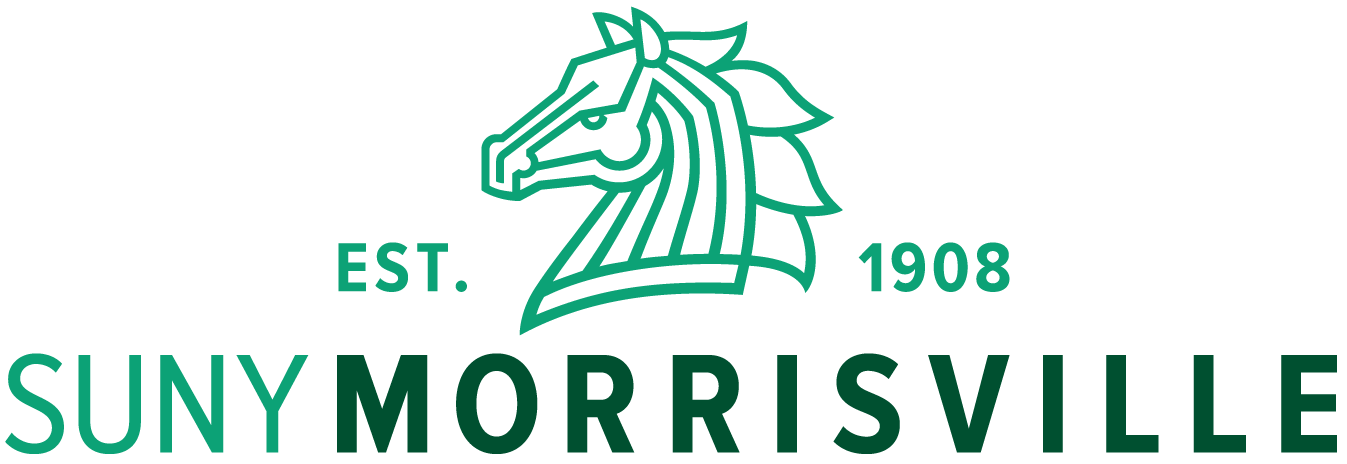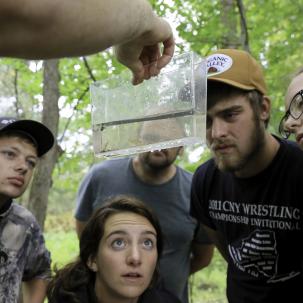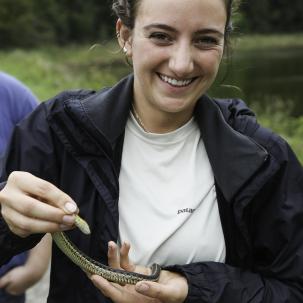SHERBURNE, NY—Talon Abrams has been fascinated with amphibians and reptiles since he was 4 years old, catching snakes and frogs in a backyard creek at his Madison home. Some even made their way into his bedroom so he could examine them more closely in a glass bowl.
That allure eventually led him to SUNY Morrisville to pursue a bachelor’s degree in renewable resources technology. He wants to land in a career where he can help aquatic life, animals and the environment.
Much of Abrams’s coursework at SUNY Morrisville is paving that groundwork for his future, including “live learning” going on in Eric Diefenbacher’s Herpetology and Introduction to Biology classes, which have students already digging into their future careers.
Diefenbacher, assistant professor of biology at SUNY Morrisville’s Norwich Campus, recently took his Herpetology class to Rogers Environmental Education Center in Sherburne, where they retrieved hoop traps for turtles and larval amphibians, and identified, measured and handled what they collected.
It was Abrams’s first experience with a snapping turtle. He learned the proper way to hold and measure a live 20-pounder they humanely trapped and released, as well as characteristics of the reptile noted for its powerful beaklike jaws. He also measured a tadpole in his palm and learned how to delineate a green frog from a bullfrog by the ridges that run the length of its back.
Students also learned how to set up and tear down a turtle net and documented their day’s findings in yellow field books.
“This is stuff you don’t get to do every day,” Abrams said. “This is so hands-on. You are actually doing work you would do if you had a job in this field.”
It’s the first time Diefenbacher has offered the Herpetology course, which meets at different locations once a week.
“We get to experiment. They are setting the bar for future students,” he said.
The elective class gives students actual experience with reptiles and amphibians in their natural environment.
Phil Keville, a renewable resources technology student from Oneida, is interested in a career in captive breeding sea turtles and releasing offspring. “I specifically took this course because we will learn about breeding reptiles and that is important for what I want to do,” he said.
“I am a hands-on learner,” said Kate Augustine, a renewable resources technology student from Saranac Lake, who jumped at every opportunity to hold the live species they studied during the visit, including an American toad, green frog, snapping turtle and tadpoles.
In addition to Rogers Environmental Education Center, the Herpetology class also ventured to Owens West Wildlife Management Area at Morrisville’s main campus to search for, identify and learn how to measure amphibians.
Students had the opportunity to catch three species of salamander, including larvae, along with a species of toad. They used field microscopes to view the general anatomy and cell size of living specimens, as well as observe the cardiac rhythm through the skin and the blood circulation in the gills of larval stream salamanders.
Diefenbacher’s Introduction to Biology students are hands-on, too. They set up and programmed data loggers to record temperature and humidity data as part of a climate lab. The project, made possible by contributions from SUNY High Impact Learning and Teaching (HILT) and the Collegiate Science & Technology Program (CSTEP), saw data loggers set up in several sub-habitats of a forest to investigate how small changes can contribute to the overall climate of an ecosystem.
Diefenbacher’s work provides important research for the facilities his classes visit, and his real-life approach is giving students valuable field skills and an opportunity to explore different career choices.
“All of this experience is definitely going to help me with my career,” Augustine said. “I see a lot of jobs out there that require working with amphibians.”
“This (Herpetology) has been my favorite class by far,” Abrams said.
“Judging by the smiles on their faces, they like this class,” Diefenbacher said.


